Lately I’ve been having a lot of conversations around investment terms with searchers, as well as investors.
About 15 years ago, I interned at a search fund. And, over the last few years, I’ve started to invest in the asset class going direct as well as through funds of search funds.
Investing in search funds is a great way to scratch my entrepreneurial itch, extremely rewarding when a searcher finds success, and can be economically rewarding too.
This post is my attempt to share thoughts on self funded search economics in an effort to contribute to the search fund community, get feedback on my thinking from a wider audience, and of course meet more people who are doing searches/investing and may want to collaborate (please feel free to reach out!).
You can watch a video of me explaining this model here, and download the excel here:

Enterprise Value
The standard finance equation is enterprise value = debt + stock – cash. Enterprise value is how much the company itself is worth. Many times people confuse it with how much the stock is worth and find the “minus cash” part of this really confusing.
So, you can rearrange this equation to make it stock = enterprise value – debt + cash. Make more sense now?
Enterprise value is just how much you’re willing to pay for the company (future cash flows, intellectual property, etc), not the balance sheet (debt and cash).
Most investors and searchers think about the EBITDA multiple of a company on an enterprise value basis because they’ll be buying it on a cash free, debt free basis. It becomes second nature to think about EBITDA multiples and know where a given business should fall given scale, industry, etc.
However, I believe this second nature way of thinking of things can be a massive disadvantage to investors given the way EV and multiples are talked about in our community currently.
Sources of capital, the typical way to calculate enterprise value for self funded searchers
If you’ve ever looked at or put together a teaser for a self funded search deal, you will notice that the deal value is equal to the sum of the sources of capital minus deal fees and cash to the balance sheet.
As a simple example, if there is $4 mm of debt to fund the deal, $1 mm of equity, and $200k of deal fees, the enterprise value = $4 mm + $1 mm – 200k = $4.8 mm.
We’ll use slightly more complex numbers in our example: If a searcher is taking a $3.2 mm SBA loan, $850k seller note, putting in $120k themselves, getting $350k of equity from the seller, a $500k earnout, and $1.2 mm of equity financing minus $350k to the balance sheet and $250k of deal fees, then the enterprise value will be $5.62 mm.
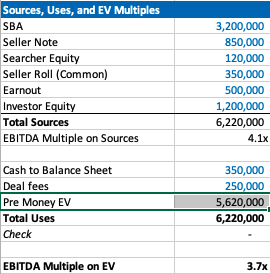
Our example company has $1.5 mm of EBITDA, so the EBITDA multiple is 3.7x. This is a pretty attractive acquisition multiple for a business that meets traditional search criteria (recurring revenues, fragmented competition, high gross margins, low customer concentration, etc).
If you’re seeing a search fund deal for the first time, the headline of “we’re buying a decent company for 3.7x, and replacing a tired owner with a hungry operator” is pretty exciting!
However, if you’re an investor, there is some nuance to this enterprise value number and the true EBITDA multiple you are investing in.
The trick with self funded enterprise value
The security that most self funded search investors get in a deal is participating preferred stock with a paid in kind dividend. This means when there’s an exit, you get your money back before any other equity holder, then get a certain percent of the business, and whatever dividend you’ve been owed in the interim accrues to your principle.
It’s a really favorable security for the investor, and one that is basically impossible to get in VC where straight preferred stock is much more common (no pun intended).
The key terms are what percent of common equity does this security convert into after the originally principal is paid back, and what is the dividend.
The share of common equity the investor group will get typically ranges from 10-50% of the total common stock. The dividend rate is usually 3-15%. The average I’m seeing now is around 30% and 10% for common and dividends respectively.
The strange this about the enterprise value quoted to investors in a teaser/CIM is that it doesn’t change as the percent of common changes, even though this has large implications for how much the common equity is worth and the value investors receive.
For example, I may get a teaser where the sources of investment – cash to balance sheet – deal fees = $3.7 mm for a $1 mm EBITDA company, which would imply a 3.7X EBITDA multiple. Let’s say the searcher is offering investors 30% of the common and a 10% dividend.
Let’s now say that the searcher is having a tough time raising capital and changes their terms to 35% of common and a 12% dividend. Does the effective enterprise value change for investors? I would argue yes, but I would be surprised to see it changed in the CIM/teaser.
This isn’t a knock on searchers or the search fund community. It’s just kind of how things are done, and I think this is mostly because it’s really hard to think about how the enterprise value has changed in this scenario.
However, the natural way of using EBITDA multiples to think about value for a business that is so common in PE/SMB can be extremely misleading for investors here. You may be thinking 3.7X for this type of business is a great deal! But, what if the security you’re buying gets 5% of the common?
If you’re in our world, you may counter this point by saying most searchers will also supply a projected IRR for investors in their CIM. However, IRR is extremely sensitive to growth rate, margin expansion, and terminal value. While the attractiveness of the security will be reflected, it can be greatly overshadowed by lofty expectations.
To get more clarity and have a slightly different mental model on the effective price investors are paying for this business, let’s go back to basics. Enterprise value should be debt + preferred stock + common stock – cash.
We know the values of each of these numbers, except the common. So, the main question here becomes: how much is the common equity worth?
Calculating value of common equity for self funded search funds
Equity value for most search fund deals = preferred equity from investors + the common equity set aside for the searcher and sometimes also advisors, board, seller.
We know that the preferred equity is investing a certain amount for a certain amount of common equity. The rub is that they are also getting a preference that they can take out before any common equity gets proceeds, and they are getting a dividend.
So, the exercise of valuing the common equity comes down to valuing the preference and dividend.
In my mind, there are three approaches:
- The discount rate method where you take the cash flows you’ll get in the future from the pref/dividends and discount them back at the discount rate of your choice. I am using 30% in my model which I believe accurately compensates investors for the risks they are taking in a small, highly leveraged investment run by an unproven operator. If you believe in efficient markets, this number also fits as it mirrors the historical equity returns as reported by the Stanford report, with a slight discount given this asset class has clearly generated excess returns relative to other assets on a risk adjusted basis, hence interest in these opportunities from an expanding universe of investors.
- The second method is to calculate how much money you’d get from your preference and dividends, taking into account that per the Stanford study around 75% of search funds will be able to pay these sums, and then discount these cash flows back at a rate more in line with public equities (7% in my model). This yields a much higher value to the preference/dividend combo, and therefore lowers the implied value of the common equity.
- The last method is to just say nope, there is no value to the preference and dividend. I need them and require them as an investor, but they are a deal breaker for me if they aren’t there, and therefore they don’t exist in my math. This of course makes no logical sense (you need them, but they also have no value?), but I’ve left it in as I think many investors probably actually think this way and it creates a nice upper bound on the enterprise value. Side note, as with obstinate sellers, jerk investors are usually best avoided.
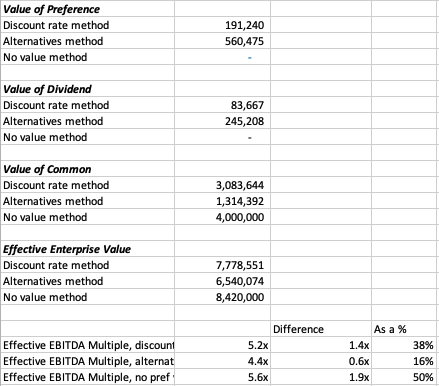
In our example, you can see a breakdown of the preference value, dividend value, and therefore common value and enterprise value for this deal.
In each case, the effective EBITDA multiple moves from 3.7x to something much higher (see the last 3 lines).
There are some simplifying assumptions in the model (no accruing dividend, all paid in last year), and some weird stuff that can happen (if you make the hold time long and the dividend greater than the 7% equity discount rate, the value of the dividend can get really big).
These flaws aside, I think this creates a nice framework to think through what the common is actually worth at close, and therefore what enterprise value investors will be paying in actuality.
It’s worth noting that the whole point of this is to benchmark the value you’re getting relative to market transactions in order to understand where you want to deploy your capital.
This creates a method to translate cash flow or EBITDA multiples of other opportunities on an apples to apples basis (if only there were a magical way to translate the risk associated with each as well!).
Another note, we could calculate the value of the common to be what this asset would trade at market today in a well run auction process minus any obligations (debt, preference, seller financing). However, I think that understates the option value inherent in this equity, a value that is only realized when a new manager takes over with more energy and know how.
There is a finance nerd rational for this. If you plot the value of equity in a leveraged company on a chart, it mirrors the payout of a call option. In both cases, the value of the security increases at a certain inflection point: when the value of equity rises above the strike price in an option, and when the enterprise value of a company rises above the debt level in a levered company.
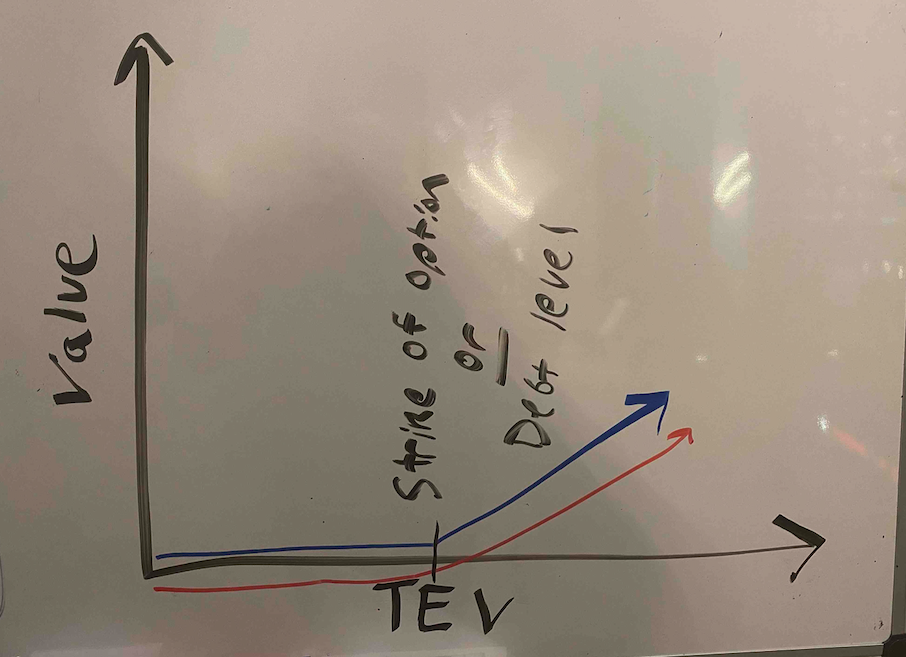
The common equity of a highly levered company can therefore be valued by a similar methodology as the call option: Black Scholes. If you remember back to finance class, increasing volatility will increase the value of an option.
In the search fund case, we’ve (hopefully) increased the (upside) volatility and therefore create more value than simply selling the company today.
A few more thoughts on investor economics
There are a few other ways to think about the economics you get as an investor to best understand if this is the deal for you.
First, you may want to think about how much your investment will be worth day 1. The key lever in this model is what discount this company is being bought for relative to fair market value. For example, the searcher may have proprietary sourced a great company and is buying it for 25% below what it would trade at in a brokered auction.
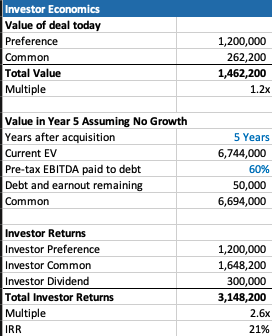
This is very much a “margin of safety” philosophy on things. Same with the calculation on how much you’ll receive in year 5 (after QSBS hits) assuming no growth in the business.
The only problem with each of these calculations is that they never play out in practice. Most companies don’t just stay the same, you’re either in a rising tide or you’re in trouble. And, you’re almost never going to sell in year 1, and definitely not for a slight premium to what it was bought for.
However, if your investment is worth 30% higher day one, and you can make a 20% IRR assuming nothing too crazy happens either way in the business, that’s not a bad place to start. Add in a strong searcher, decent market, some luck, and you’re off to the races.
Thoughts on searcher economics
A lot of this post has considered things from the investor perspective as my main quandary was related to how to create an EBITDA multiple that made sense for investors.
However, the point of this post is not to say searchers are misrepresenting or being unrealistic with their terms. In fact, I think it’s quite logical that self funded searchers capture the massive economic value that they do.
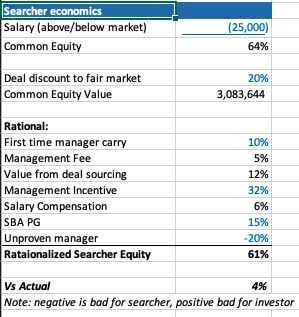
There are many reasons why self funded searchers deserve the lion share of the common equity.
First, they are providing a nice service of giving investors a positive expected value home to park their money with much lower correlation to the market than other asset classes ($1 mm EBITDA companies don’t see lots of multiple contraction/expansion throughout cycles).
Most money managers that fit that criteria are taking a 2/20, of course they also usually have a track record. So, I’ve used a 10% carry in my model, but stuck to 2% annual management fee.
The searcher spent a lot of time, and probably money, finding this company. That’s a lot of value, especially if it’s a below market price. They should be able to capture a lot of the value in finding a below market deal.
The searcher may be taking a below market salary, and needs to get comped like any CEO, with stock options. In my example model I have $1 mm of stock vesting over the hold period, as well as extra comp for taking a below market salary.
Searchers are also usually putting their financial standing at risk by taking a personal guarantee on the bank/SBA loan. This is really tough to put a number on, as is the last line in my framework where searchers are dinged for lack of experience. Like any good model, you need a few lines that you can fudge to make the math work 🙂
What you do think?
I’m shocked that I wrote all this. I was going to type a few paragraphs and a quick excel. However, putting this to paper has been a great exercise for me to sharpen my thinking.
Now I’d like you to help me further. Where do you think this should be changed in this framework? How do you think about things from the investor and/or searcher side?
Feel free to shoot me a note if you have thoughts (even just to tell me I’m being way too academic with this, which I actually agree with).
Lastly, a post like this is really a trap I’m putting on the internet to catch any like minded people in so that we can figure out ways to collaborate now or in the future. So, at the very least, connect with me on LinkedIn 🙂

Hello! I’m at work surfing around your blog from my new iphone 3gs!
Just wanted to say I love reading your blog and look forward to
all your posts! Carry on the excellent work!
Undeniably believe that that you stated. Your favorite
justification appeared to be at the internet the easiest factor to
have in mind of. I say to you, I definitely get annoyed at the same time as other people consider worries that they plainly do not realize about.
You managed to hit the nail upon the highest as smartly as defined
out the whole thing with no need side effect , other folks can take a signal.
Will likely be again to get more. Thank you
Hi would you mind sharing which blog platform you’re using?
I’m planning to start my own blog in the near future but I’m having a
tough time selecting between BlogEngine/Wordpress/B2evolution and Drupal.
The reason I ask is because your design and style seems different then most blogs and I’m looking for something
unique. P.S Sorry for getting off-topic but I had to
ask!
Whats up very cool site!! Guy .. Beautiful .. Amazing .. I’ll bookmark your blog
and take the feeds also? I’m happy to search out
a lot of helpful information here in the post, we need develop
more strategies on this regard, thank you for
sharing. . . . . .
excellent publish, very informative. I’m wondering why the opposite specialists of this sector don’t understand
this. You should proceed your writing. I am sure, you’ve a great readers’ base already!
I don’t know if it’s just me or if perhaps everyone else experiencing problems with your site.
It seems like some of the text within your content are running off the screen. Can somebody else please comment and let me know if this
is happening to them as well? This may be a problem with my web browser because I’ve had this happen previously.
Thank you
Tremendous issues here. I am very happy to peer your post.
Thanks a lot and I’m looking forward to contact you.
Will you please drop me a e-mail?
Cool blog! Is your theme custom made or did you download it
from somewhere? A design like yours with a few simple tweeks
would really make my blog shine. Please let me know where you got your theme.
Many thanks
Wonderful post but I was wondering if you could write
a litte more on this topic? I’d be very grateful if you could elaborate a little bit further.
Cheers!
Hello! Would you mind if I share your blog with my
zynga group? There’s a lot of folks that I think would really appreciate your content.
Please let me know. Cheers
I’m not positive the place you are getting your information, but
great topic. I needs to spend some time learning much more or
working out more. Thank you for fantastic info I used to be looking for
this information for my mission.
It’s awesome in favor of me to have a web page, which is useful for my experience.
thanks admin
Heya i’m for the first time here. I came across this board and I find It
truly useful & it helped me out much. I hope to give something back and aid others
like you helped me.
Please let me know if you’re looking for a article writer for your
weblog. You have some really good posts and
I feel I would be a good asset. If you ever
want to take some of the load off, I’d love to write some material
for your blog in exchange for a link back
to mine. Please send me an email if interested.
Kudos!
If you want to improve your familiarity simply keep visiting this website and be updated with the latest news posted here.
Wow, that’s what I was looking for, what a stuff!
existing here at this blog, thanks admin of this web
page.
Have you ever thought about writing an e-book or
guest authoring on other blogs? I have a blog based upon on the same subjects you
discuss and would love to have you share some stories/information. I know my visitors would enjoy your work.
If you are even remotely interested, feel free to shoot me an e-mail.
Thanks for another informative website. Where else may I get that type of info written in such a perfect method?
I have a mission that I’m just now operating on, and I’ve
been at the look out for such information.
Good day! I just wish to give you a big thumbs up
for your great information you have got here on this post.
I am returning to your blog for more soon.
bookmarked!!, I love your site!
It’s going to be finish of mine day, but before ending I
am reading this fantastic post to increase my experience.
I needed to thank you for this very good read!! I definitely loved every bit of it.
I’ve got you book marked to look at new stuff you post…
This is a topic that is close to my heart…
Cheers! Exactly where are your contact details though?
I like the valuable information you supply for your
articles. I will bookmark your blog and take a look at again here regularly.
I’m somewhat sure I will be told a lot of new stuff
proper here! Best of luck for the next!
After I originally commented I seem to have clicked the -Notify me when new comments are added- checkbox and now every time a comment is added I
get four emails with the exact same comment. There has to be an easy method you can remove
me from that service? Cheers!
Thanks for your marvelous posting! I genuinely enjoyed reading
it, you could be a great author.I will remember to bookmark your
blog and will often come back very soon. I want to encourage yourself to continue your great posts, have a nice morning!
Everything is very open with a really clear clarification of the
issues. It was definitely informative. Your site is
very useful. Thanks for sharing!
My brother suggested I may like this website. He was once
entirely right. This publish truly made my day. You can not believe just how much time I had spent for this information! Thank you!
I am genuinely delighted to read this weblog posts which
consists of plenty of valuable information, thanks for providing such information.
bookmarked!!, I really like your blog!
Hi, I think your website might be having browser compatibility issues.
When I look at your website in Opera, it looks fine but when opening in Internet Explorer, it has some overlapping.
I just wanted to give you a quick heads up! Other then that, excellent blog!
When I initially commented I clicked the “Notify me when new comments are added” checkbox and now each
time a comment is added I get several emails with the
same comment. Is there any way you can remove me from that service?
Appreciate it!
There is certainly a lot to learn about this topic.
I love all the points you made.
I was recommended this website by my cousin. I
am not sure whether this post is written by him as no one else know such detailed about my difficulty.
You’re incredible! Thanks!
Hey there I am so glad I found your website, I really
found you by mistake, while I was looking on Google for something else,
Regardless I am here now and would just like to say thanks a
lot for a fantastic post and a all round enjoyable blog (I
also love the theme/design), I don’t have time to read through it all at the minute but I have
saved it and also added in your RSS feeds, so when I have time
I will be back to read more, Please do keep up the
awesome work.
Nice post. I learn something new and challenging on blogs I stumbleupon on a daily basis.
It will always be interesting to read through content from other authors and practice something from other web sites.
I’m gone to convey my little brother, that he should also go to see this
webpage on regular basis to take updated from newest information.
I’m not certain where you’re getting your info, but good topic.
I needs to spend some time learning much more or figuring out more.
Thanks for fantastic info I used to be looking for this information for my mission.
It is the best time to make some plans for the future and
it’s time to be happy. I have read this post
and if I could I want to suggest you few interesting things or tips.
Perhaps you could write next articles referring to this article.
I desire to read more things about it!
First of all I want to say superb blog! I had a quick question which I’d like to ask if you don’t mind.
I was curious to find out how you center yourself and clear your head prior to writing.
I have had trouble clearing my mind in getting my thoughts out there.
I truly do take pleasure in writing however it just seems like the
first 10 to 15 minutes are wasted just trying to figure out
how to begin. Any ideas or hints? Thank you!
I read this post completely about the resemblance of latest
and preceding technologies, it’s amazing article.
Thanks for your marvelous posting! I definitely
enjoyed reading it, you are a great author.I will make sure
to bookmark your blog and will come back in the future. I want to encourage that
you continue your great job, have a nice day!
hi!,I love your writing very a lot! share we keep in touch extra about your post on AOL?
I require an expert on this space to unravel my problem. May be that
is you! Taking a look forward to see you.
Why people still make use of to read news papers when in this
technological world all is available on net?
Write more, thats all I have to say. Literally, it seems as though you relied on the video to make your point.
You definitely know what youre talking about, why
waste your intelligence on just posting videos to your
site when you could be giving us something enlightening to read?
It’s going to be end of mine day, however before finish I am reading this great paragraph to increase my know-how.
Hi, just wanted to tell you, I liked this blog post.
It was funny. Keep on posting!
I am actually grateful to the owner of this website who has
shared this fantastic article at at this time.
Greetings! This is my first visit to your blog! We are a team of volunteers and starting a new initiative in a community in the same niche.
Your blog provided us useful information to work on.
You have done a extraordinary job!
I loved as much as you’ll receive carried out
right here. The sketch is tasteful, your authored subject matter stylish.
nonetheless, you command get bought an shakiness over that you wish be
delivering the following. unwell unquestionably come further formerly again since exactly the same
nearly very often inside case you shield this increase.